- その他のフルークグループ:
- Fluke
- Fluke Biomedical
- Fluke Networks
- Fluke Process Instruments
Why did my temperature sensor fail calibration?
By Steve Iman

Temperature is the most commonly measured parameter in the world. Temperature sensors are used in instruments designed for measuring temperature. To be accurate, all temperature sensors must be calibrated against a known standard. Only short-term stability is checked during calibration. Long term stability should be monitored and determined by the user.
Occasionally, a temperature sensor might fail during calibration. This can happen even though the temperature sensor seemed to be functioning properly prior to sending it in for calibration. This article gives some basic reasons for temperature sensor failures and offers some suggestions to ensure their accuracy and maximize their useable life. In addition, some background knowledge is given on each temperature sensor type, including basic characteristics and their limitations.
Common temperature sensor types
Thermistors, platinum resistance thermometers (PRTs), and thermocouples are the instruments of choice for most temperature measurement applications. Each has specific characteristics and limitations. Normally, these instruments are reliable and give years of trouble-free service. Mistreating them, however, greatly affects their accuracy and useful life. Therefore, it’s imperative that they be handled and used properly. To do so, you must understand how they operate and what their limitations are.
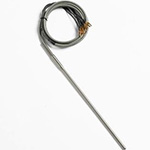
Thermistors
Thermistors are among the most robust of all temperature sensors. They are constructed of a solid-state device that acts like a variable resistor. As the temperature changes, so does its resistance. These devices have excellent sensitivity and accuracy. They come in a wide range of resistance values. They have excellent long-term drift characteristics and are not shock sensitive, nor do they suffer from other concerns that other thermometer types may have. Because they are not shock sensitive, their calibrations generally are not affected by minor vibration, being bumped or dropped. However, their temperature ranges are usually limited to 100 ºC span.
Platinum resistance thermometers (PRTs)
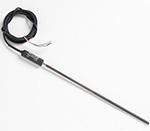
PRTs are perhaps the most versatile of all temperature sensors because of their wide temperature range and high accuracy. Most are usable from -196 ºC to 420 ºC, with a few exceptions that reach up to 500 ºC or even higher. This, of course, depends on individual model specifications and their respective calibrations.
Even though PRTs are highly accurate and cover a wide temperature range, they do have limitations. Unlike thermistors, PRTs are subject to changes in calibration if the platinum wire is contaminated, exposed to vibration, bumped or dropped. Changes in calibration through these processes are cumulative. Therefore, great care must be taken when handling and using PRTs.
Thermocouples
Base metal thermocouples have advantages in that they have a very broad temperature range and are low in cost. Their disadvantages include relatively low accuracy, and, at very high temperatures, they are susceptible to inhomogeneity. Nobel metal thermocouples have a very broad temperature range with higher accuracy, but they cost more. Like base metal thermocouples, they are also susceptible to inhomogeneity.
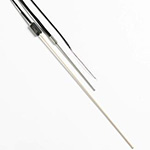
Causes of failure during calibration
Self-heating in thermistors and PRTs
When thermistors and PRTs are calibrated, a nominal excitation current is applied. The amount of current that’s required is generally stated on the calibration report or manufacturer’s specifications.
We learn from Ohms Law that when a current flows through a resistor, power is dissipated (I2R). This power causes the sensor to heat; which is known as “self-heating.” When the temperature sensor is calibrated, its self-heating has been accounted for.
When using either sensor type, be sure to set the readout for the proper excitation current. Too little or too much current will cause measurement errors. These sensors can even be damaged if too much current is applied.
Some readouts will automatically choose the proper current when either “thermistor” or “PRT” is selected. Others may need to be set manually. The settings are generally in the probe setup menu. If you select the current manually, always refer to the thermometer’s specifications or calibration report for the proper current.
Low insulation resistance and leakage currents
Low insulation resistance is sometimes referred to as shunt resistance, because current is allowed to flow outside of the measurement circuit. Electrically, it is like putting another resistance in parallel with the sensor. When low insulation resistance occurs, too often the transition junction temperature has become too hot. (The hub should not be so hot that it is painful to touch.)
Additionally, low insulation resistance may result if the sheath has been bent, or if the seal has been compromised, allowing moisture to reach the sensor and lead wires. This problem usually can be avoided through proper use and handling.
Transition junctions
Thermistors and PRTs generally have transition junctions. The transition junction is where the cable lead wires connect to the sensor lead wires. The lead wires will either be soldered or spot welded. If they are soldered and the junction gets too hot, the solder will melt, causing an open or intermittent condition.
Usually, the junction is sealed with epoxy to keep out moisture and other contaminants. If the seal is subjected to temperatures that are beyond what the epoxy can handle, the seal may crack. This allows moisture and other contaminants to penetrate the seal and reach the lead wires and sensor. Moisture accumulation is most noticeable when the temperature sensor is left to soak at temperatures below ambient or if the ambient humidity is high.
PRTs are often packed with powdered insulative material. This material makes the PRT less susceptible to stress caused by mechanical shock. Unless a good seal exists, at low temperatures the insulation absorbs moisture from the air. Moisture or other contaminants create errors in the measurements and cause the temperature sensor to fail calibration. Trapped moisture can also present a safety concern. If the insulation has absorbed a lot of moisture and the temperature sensor is put into a high temperature heat source, the moisture will turn to steam, possibly causing the seal to blow or rupture the sheath.
Broken or intermittent lead wires
If the temperature sensor cable is pulled, overworked or stressed, the lead wires may break, causing an open or an intermittent connection. On occasion, open or intermittent sensor or sensor lead wires may occur. Some intermittent events are not noticeable until the temperature sensor is heated, causing the wire to expand and separate.
Even if great care has been taken to prevent broken or intermittent connections, they still may occur given enough time and use. The repeated expansion and contraction of the lead and sensor wires may eventually take its toll, causing the wire to break.
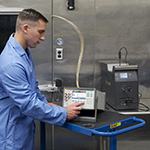
Contamination
Contamination can be caused by chemicals, metal ions or oxidation.
Chemical contamination can occur in PRTs if a liquid reaches the lead or sensor wires. This can change the purity of the platinum, which alters its electrical characteristics. Any changes in the purity will be permanent.
Metal Ion contamination of platinum wire usually occurs at 600 ºC and higher. Because PRT sensors are manufactured using high purity platinum wire, they are the most susceptible to this type of contamination. Metal ion contamination is not reversible and will cause a PRT to constantly drift upwards in temperature. This is particularly noticeable in a triple-point-of-water cell, where the reference temperature is extremely stable. When a PRT is manufactured for extremely high temperatures, it’s constructed in such a way that the sensor is protected from ion contamination.
Temperature sensor sheaths are usually sealed to guard against contamination. Both industrial and secondary temperature sensors are not evacuated before being sealed. Generally, therefore, there will be some dry air inside them. When they are exposed to various temperatures, oxidation can form on the surface of the wire. Oxidation primarily affects temperature sensors whose sensing elements contain platinum wire. Oxidation causes an increase in RTPW (resistance at the water triple point) in metallic RTDs. Fortunately, oxidation can be removed by annealing the RTD, using the manufacturer’s recommended temperature and procedure. Before and after annealing, compare the temperature sensor with a standard of superior accuracy such as a triple point of water cell. This allows you to determine whether the procedure was successful, and it helps you keep a history of the temperature sensor’s performance.
Hysteresis and non-repeatability
Hysteresis is a condition in which temperature sensor’s readings lag behind or appear to have a “memory” effect as the thermometer is moved through a sequential range of temperatures. Measured values depend on the previous temperature in which the sensor or wire was exposed. If a temperature sensor is taken through a range of temperatures for the first time—let’s say, from cold to hot—it will follow a particular curve. If the measurements are repeated in the reverse order, (hot to cold in our example), a thermometer that has a hysteresis problem will have an offset from the previous set of measurements. If repeated, the amount of offset may not always be the same.
Hysteresis does not occur with undamaged standard platinum resistance thermometers (SPRTs), because SPRTs are designed to be strain free. PRTs that are designed to be rugged, however, do not have a strain-free design and have at least some hysteresis. Moisture ingress, or moisture penetrating inside the temperature sensor, causes hysteresis in RTDs of any type.
Inhomogeneity
When a thermocouple is used at high temperatures, its wire may become contaminated. This causes the local Seebeck coefficient of the wire to change from its initial state. In other words, this alters the sensitivity of the wire to changes in temperature. However, the temperature exposure and contamination may not be uniform along the length of the thermocouple. The Seebeck coefficient then becomes a function of position along the thermocouple. This leads to measurement errors that depend on the temperature profile the thermocouple is exposed to all along the length of the thermocouple, and not just the temperature at the measurement junction.
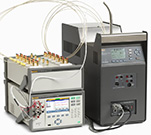
Short-term stability
Measurement repeatability is a term than can be used many different ways. It should be defined by the person using the term. It often refers to the RTPW repeatability during a segment of thermal cycling or a calibration process.
When a temperature sensor fails to meet its short-term stability specification, it means the deviation between measurements at a particular temperature is outside its specification. This could be caused by a large standard deviation or by readings that continually drift in one direction. Potential causes for short-term stability problems include:
- Moisture
- Contamination
- Strain
- Leakage current
- Mechanical shock
- Inhomogeneity
To prevent temperature sensor failure and avoid contamination, you should take proper precautions when using temperature sensors in harsh environments. Do not subject the transition junction to higher or lower temperatures than the epoxy seal or transition junction can handle. Refer to the temperature sensor’s specifications or contact the temperature sensor manufacturer for the transition junction temperature specification. If there is a possibility that the transition junction could be exposed to high or even marginally high temperatures, a heat shield or heat sink is recommended.
Other ways to help prevent failure:
- Do not drop, bump, or vibrate a PRT.
- Never bend a sheath that isn’t designed to be bent. Even slight bends may adversely affect the calibration or temperature sensor life.
- Never submerge the transition junction into a liquid.
- Never exceed the temperature specification of the temperature sensor.
- Do not soak temperature sensors for long periods of time, particularly at temperatures where oxidation is likely to occur.
- Do not pull or overly strain the temperature sensor cable.
- If a temperature sensor requires annealing, use recommended temperatures and techniques. Afterwards, always verify the temperature sensors accuracy by comparing it against a primary standard.
- Periodically compare the temperature sensor’s accuracy to a primary standard, such as a water-triple-point cell or a calibrated SPRT (standard platinum resistance thermometer).
Additional Resources
Article - Calibrating Industrial Temperature Sensors >>
Application Note - Eliminating Sensor Errors in Loop Calibrations >>
Related products
Probes / Sensors (PRTs, Thermistors, and Thermocouples) >>
Digital Thermometer Readouts (DRTs) >>
Industrial Temperature Calibrators (Dry-Wells, Metrology Wells, and More) >>
- ホーム
- 製品
- ご購入について
- ニュース
- トレーニングとイベント
- カタログ・資料
- サービスとサポート
- フルーク・キャリブレーション

